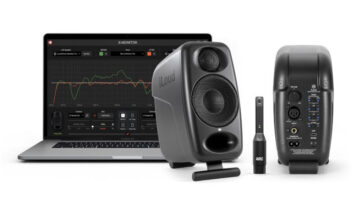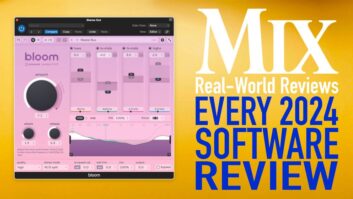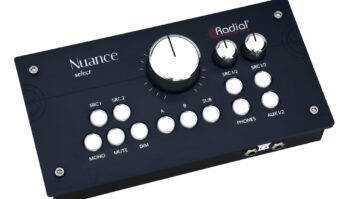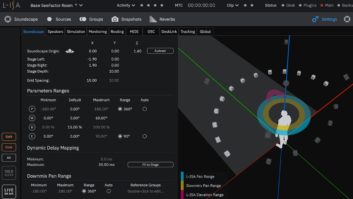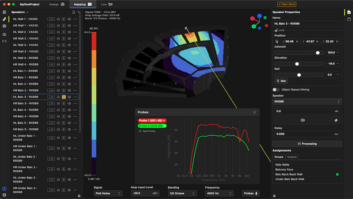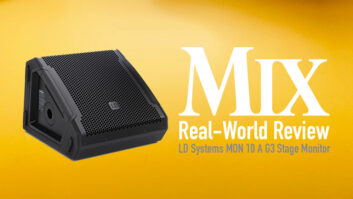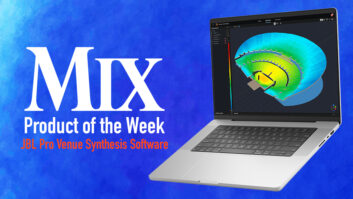Patented software improves listening conditions
San Diego, CA –April 16, 2010… Equator Audio Research, recognized globally as a leading manufacturer of highly accurate studio reference monitors for mission critical recording applications, is pleased to announce that the Automated Room Response Calibration Software featuring the patented Secondary Reflection Correction will now be included on a CDROM packaged with every Q15 reference monitor. This high powered 15″ two-way coaxial monitor ($3000 each) has a 4″ voice coil for the large driver and uses a horn loaded 1.3″ titanium dome rear firing compression drive.
Recognizing the actual listening room’s contribution to the monitoring quality, Equator Audio Research developed the Automated Room Response Compensation Software to tame unwanted sonic conditions and aid in achieving a more accurate listening result.
Equator believes that the single most important position
in the control room is the engineer’s seat. By placing a small diaphragm Omni-directional condenser test mic at that position the Equator Automated Room Response Calibration Software is able to evaluate exactly what is sonically occurring at that spot. The host computer calculates and then sends compensation data back to each speakers internal CPU so that each speaker in turn delivers the appropriate audio. An enormous amount of processing power is incorporated: multiple filters are available to compensate for each speakers boundary condition, location, existing room nodes and other EQ issues as well as time based secondary reflection comb filter phase problems.
The MAC/PC software resides on the recording computer utilizing that A/D hardware. The Equator Q Series Monitors each feature an internal CPU. On the back of each are a CAT5 in and Thru, a series of dip switch IDs, a USB connection as well as the standard audio inputs. A USB connection from the computer to any of the monitors in a system and a daisy chained CAT5 connection ready the system for room compensation.
Upon launching the software, the system is interrogated and the appropriate speakers populate the software screen. The software works for any system from stereo to 8.2. If there is a 7.1 system all 8 speakers (7 satellites and a sub) will pop up on the screen.
Assigning the audio inputs and outputs, placing the mic and adjusting its level, inputting the single largest room dimension is all the additional information needed. The software generates a series of perfectly timed white noise bursts which are followed by a frequency sweep. These signals cascade around the system, one speaker at a time. The white noise bursts allows the software to determine monitor location as well as evaluate each reflection in time and size as they relate to the initial bursts. The frequency sweep allows the evaluation of EQ based phenomena … nodal and anti-nodal conditions.
Once the sonic condition of that location has been evaluated, the appropriate compensation is calculated and communicated back to each speaker. That information is stored within each speaker while remaining completely editable at anytime to individual taste. Each of the compensations can be bypassed or compared to the previous compensation. Multiple compensated microphone locations can be titled and stored allowing them to be recalled. The monitors can be brought back to factory flat at any time. The software also allows for personal voicing adjustments to the monitors as well as mute and solo for each monitor.
“As we’ve placed many Q15s in high end studios around the globe,â€? stated Ted Keffalo Equator Audio President, “it became apparent that most are already equipped with a fine test microphone and including the software on a CDROM with every flagship Q15 model shipped seemed quite appropriate.â€? “The software works with all Q Series monitors, the$495 room calibration mic kit will still be available for purchase for those needing the software and a test mic.”
About Equator Audio Research
Equator Audio Research is committed to delivering studio reference monitor solutions that overcome the myriad of challenges faced in today’s production environment. Audible obstacles such as comb-filtering from computer screens and consoles, standing waves, uneven first reflections, asymmetrical speaker placement, and poor low frequency diffusion can easily degrade the listening experience. Equator Audio Research designs products that overcome these challenges. Our products are used daily in mission-critical applications at many of the world’s finest recording studios. For additional information on all Equator Audio products, visit the company online at www.equatoraudio.com
